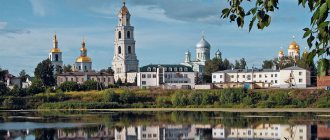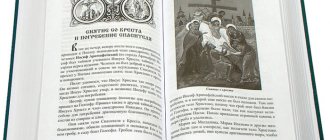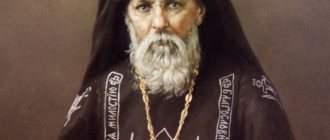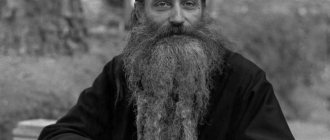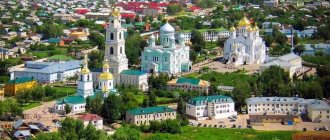There is a mailbox in the crypt of the Russian Church of St. Nicholas Cathedral in Bulgarian Sofia. Believers place letters with prayer requests addressed to the saint, Archbishop Seraphim (Sobolev).
Even during his lifetime, Vladyka possessed the gift of prayer and insight. He told his spiritual children that after his death they should come to his grave and address him as if he were alive. Until now, many believers fulfill this covenant and receive help from the saint at their requests.
Bishop Seraphim was born into a family of philistines
The future Bishop Seraphim was born into a large pious family of bourgeois Boris Matveevich and Maria Nikolaevna Sobolev on December 1, 1881.
He was baptized under the name Nicholas in honor of St. Nicholas of Mirilicia.
His brother is Archimandrite Sergius (Sobolev). He received his primary education at a parochial school. Next, Nikolai Sobolev continued his education by entering the second grade of the Ryazan Theological School.
Here he studied diligently, willingly, receiving only good grades.
Saint Seraphim of Sarov, lifetime portrait. Saint Seraphim Sobolev received his name in honor of Saint Seraphim of Sarov. At the same time, initially they wanted to name him Dositheus. Photo: upload.wikimedia.org
After that he studied at the Ryazan Theological Seminary. Here he studied Scripture, the Lives of the saints, and the works of the church fathers. He devoted a lot of time to self-education and self-education, being under the supervision of spiritual mentors.
After successfully graduating from the Ryazan Theological Seminary, in 1904 he went to the St. Petersburg Theological Academy to study.
Here, at the end of his studies, on January 26, 1908, he was tonsured a monk under the name Seraphim, in honor of Seraphim of Sarov.
January 26, 1908
on this day Father Seraphim was tonsured a monk
It should be noted that from the moment he entered educational institutions, Father Seraphim declared his desire to devote his life to serving God. That is why he studied hard and often went beyond the curriculum.
At the same time, the figure of Father John of Kronstadt had a great influence on his formation as a monk and future clergyman. He knew all his works and respected him as his spiritual master.
Literature
- Church Led.
, 1912, № 50, 421. - —
, 1913, № 2, 10. - ZhMP
, 1945, № 5, 22. - —
, 1946, № 4, 19. - —
, 1950, № 4, 20-28. - FPS I
, №106, 4. - FPS III
, 6. - FAM I
, № 232, 18. - Eleutherius, Metropolitan, Conciliarity of the Church.
God and Caesar , Paris, 1938, 90. - Lists of bishops 1897-1944. Patriarch Alexy
, 18. - N. Rklickbij, Zizneopisanie
, V, 271; VII, 278. - G. Seide, Geschichte der ROK im Ausland
, 424, passim, bes. 426. - Irenikon
, 13 (1936) 177, 511. - Power and the Church in Eastern Europe. 1944-1953. Documents of Russian archives: in 2 volumes - M., 2009. - T. 1. - P. 121, 698-699.
- Name list of rectors and inspectors of theological academies and seminaries, teachers of theological schools and their assistants, monastic teachers of theological seminaries and schools and clergy at our foreign churches for 1913 and 1917. - St. Petersburg, 1913. - P. 70; - Pg., 1917. - P. 52.
- Saint Seraphim (Sobolev, 1881-1950): Life: exploits and miracles. - M., 1993 (Ascetics of piety of the 20th century)
- Tsypin V.A., prot. History of the Russian Church, 1917-1997.- M., 1997.- P. 762.
- About the Karlovac group // Journal of the Moscow Patriarchate. - M., 1934. - No. 22.
- Gorokhova O.V., Teachers and graduates: To the 300th anniversary of the Holy Trinity Alexander Nevsky Lavra // Provincial House: historical, local history, cultural, educational and popular science magazine. - Kostroma, 2013. - No. 3 (92).- P. 52.
- Kostryukov A.A., Overcame the division. To the biography of Archbishop Seraphim (Sobolev) // Church and Time. - M., 2006. - No. 3 (36). - P. 101-111
- Obituary // Journal of the Moscow Patriarchate. - M., 1950. - No. 4. - P. 20-28.
- State Archive of the Kostroma Region. F. 432. Op. 1. D. 4308. L. 4-5.
After completing his studies, Saint Seraphim (Sobolev) became a teacher
In 1908, Bishop Sergius (Tikhomirov) ordained Seraphim as a Hierodeacon, and later as a Hieromonk. In the same year, he defended his dissertation on the topic “Teaching of Humility according to the Philokalia” and became a candidate of theology.
Soon after this, he was appointed as a teacher at the pastoral school in Zhitomir, and then transferred to the position of assistant superintendent of the Kaluga Theological School. On December 1, 1911, Father Seraphim was appointed inspector of the Kostroma Theological Seminary.
and teacher. 1914 Father Seraphim (Sobolev) inherited the “rebellious” academy, which, under the influence of the revolutionary events of 1905, did not want to submit to the old order. Photo: dvagrada.ru
On December 22, 1912, Seraphim (Sobolev) was appointed rector of the Voronezh Theological Seminary and elevated to the rank of archimandrite.
In 1912, the situation in theological seminaries of the Russian Empire was difficult. So this year there was a riot at the Voronezh Theological Seminary, so Father Seraphim found himself in difficult conditions at his new place of service.
Because of this, he had to give up editing the Voronezh Diocesan Gazette.
Spring 1921
at this time, Archimandrite Seraphim (Sarov) emigrated from Soviet Russia to Bulgaria
Archimandrite Seraphim did not accept the revolution. In the south of Russia, Archimandrite Seraphim came under the authority of the Temporary Higher Church Administration (VTSU).
On October 1, 1920, according to the old style, his consecration took place, led by Metropolitan Anthony (Khrapovitsky) of Kiev, who later became chairman of the Synod of Bishops.
On November 14, on the commandant's ship "Chersones", together with the commandant of Sevastopol, General Nikolai Stogov, he emigrated to Constantinople.
Russian Orthodox Church
On February 3, 2021, at the fifth plenary meeting of the Consecrated Council of Bishops in the Cathedral of Christ the Savior, a decision was made to glorify Archbishop Seraphim of Bogucharsky (Sobolev, † 1950).
Nikolai Borisovich Sobolev - the future Archbishop Seraphim - was born in the city of Ryazan on December 1 (old style) 1881 in the family of the tradesman Boris Matveevich Sobolev and his wife Maria Nikolaevna. There were 12 children in the Sobolev family, seven of whom died in childhood and adolescence. Nikolai Sobolev was the tenth child in the family.
A big challenge for the Sobolev family was the sudden illness of Boris Matveevich. When Nikolai was six years old, his father suffered a stroke and was bedridden for 14 years, until his death. The atmosphere in the family was imbued with the spirit of prayer and deep awareness of the Providence of God in human life.
The future hierarch was greatly influenced by his mother, who wanted her son to be a priest. The archpastor was sincerely attached to his mother and subsequently always tried to arrange for Maria Nikolaevna not far from the place of his ministry.
In 1894, Nikolai Sobolev was admitted to the second class of the Ryazan Theological School, then graduated from the Ryazan Theological Seminary and in 1904 entered the St. Petersburg Theological Academy.
During his years of study, the future archpastor repeatedly visited the righteous John of Kronstadt, as well as the elder of the Gethsemane monastery Isidore (Gruzinsky-Kozin). Nikolai Sobolev also became close to Archimandrite Feofan (Bistrov), an inspector of the St. Petersburg Theological Academy, a strict monk and prayer book.
According to the testimony of Metropolitan Veniamin (Fedchenkov), who studied a year earlier than Nicholas, at the theological academy he was called “Ring.” This treatment was associated with the special kindness that Nikolai showed towards his fellow students. Nikolai Sobolev’s favorite pastime was playing the piano in the seminar hall and singing prayers, including his own compositions.
On January 26, 1908, Nikolai Sobolev, being a 4th year student at the academy, was tonsured a monk with the name Seraphim. On February 3/16, 1908, Monk Seraphim was ordained by Bishop Sergius (Tikhomirov) to the rank of hierodeacon, and on March 18/31 - to the rank of hieromonk.
In the fall of 1908, Hieromonk Seraphim defended his dissertation at the department of moral theology, “The Doctrine of Humility according to the Philokalia.” Reviewer Professor A.A. Bronzov highly appreciated this work as going beyond the scope of his thesis. On September 16, 1908, the Academic Council of the Academy decided to award Hieromonk Seraphim the academic degree of Candidate of Theology with the right to receive a master's degree without new oral tests.
In 1908, Hieromonk Seraphim began teaching at the Pastoral Theological School, opened by Archbishop Anthony (Khrapovitsky), then was transferred as caretaker of the Kaluga Theological School. A great consolation for Hieromonk Seraphim during this period was a visit to the Holy Vvedenskaya Optina Hermitage. He developed a particularly close relationship with the Monk Anatoly (Potapov), who became his confessor.
In December 1911, Father Seraphim was appointed inspector of the Kostroma Theological School. On December 22, 1912, Hieromonk Seraphim was appointed rector of the Voronezh Theological Seminary and elevated to the rank of archimandrite. The Voronezh seminary at the time of Archimandrite Seraphim’s arrival was considered one of the worst in terms of discipline. “You have been appointed to the most hopeless and rebellious seminary,” Archbishop Anthony (Khrapovitsky) wrote to Archimandrite Seraphim.
But Archimandrite Seraphim managed to improve the situation. He abandoned the practice of punishment against pupils, trying to understand their problems, the main one of which was poverty. The new rector achieved the opening of two canteens for low-income students, opened a fraternity that helped students pay for education, treatment and trips home. The situation at the Voronezh Seminary soon improved markedly. In 1915, a commission was sent to the seminary, which left a favorable review of it. A member of the Educational Committee at the Synod, Peter Fedorovich Polyansky (later Metropolitan Peter - Patriarchal Locum Tenens and Hieromartyr) called the seminary one of the best in Russia.
In Voronezh, Archimandrite Seraphim was caught up in revolution and civil war. In March 1918, the seminary was closed by the Bolshevik authorities, its building was occupied by the Red Army. Archimandrite Seraphim moved to the monastery of St. Tikhon of Zadonsk.
In the first half of October 1919, the troops of General A.I. Denikin took Voronezh, but were soon forced to retreat. Archimandrite Seraphim did not know what to do - go south or stay in Voronezh. For advice, Father Seraphim turned to the paralyzed elder Aaron, who lived near Voronezh. “Don’t worry, you’ll end up in a good place,” the elder said about the future fate of Archimandrite Seraphim. “How can I understand your words?” asked the archimandrite. “If you get there, you’ll know,” was the elder’s answer. Archimandrite Seraphim and his brother Hieromonk Sergius left Voronezh at the last moment in an open carriage with coal for the locomotive.
In the south of Russia, Archimandrite Seraphim came under the authority of the temporarily independent High Church Administration (HCU), formed to independently resolve urgent and important issues. On May 7, 1920, Archimandrite Seraphim was appointed rector of the theological seminary in Simferopol. Soon the question of the episcopal consecration of Archimandrite Seraphim was raised.
On September 24, 1920, the VCU decided to ordain Archimandrite Seraphim as Bishop of Lubensky, vicar of the Poltava diocese. This definition was signed by the ruling bishop of the Taurida diocese, Archbishop Dimitri (Abashidze), the ruling bishop of the Poltava diocese, Archbishop Feofan (Bistrov), Bishop of Sevastopol Veniamin (Fedchenkov) and secretary E.I. Makharoblidze. On October 14, in the Simferopol Alexander Nevsky Cathedral, Archimandrite Seraphim was ordained bishop. The consecration was performed by a host of bishops led by Metropolitan Anthony (Khrapovitsky). However, soon, in view of the Bolsheviks’ entry into Crimea, General Wrangel gave the order for evacuation and Bishop Seraphim, along with the remnants of the White Army and refugees, left his native land.
In the spring of 1921, Archbishop Evlogy (Georgievsky), administrator of Russian parishes in Western Europe, appointed Bishop Seraphim rector of St. Nicholas Church in Sofia. On August 31, 1921, the Supreme Church Administration Abroad appointed Bishop Seraphim as administrator of the Russian Orthodox communities in Bulgaria. Patriarch Tikhon recognized the episcopal consecration of Bishop Seraphim and his appointment to Bulgaria, which is confirmed by the lists of legitimate hierarchs that were secretly sent abroad from Moscow. In 1921, Saint Tikhon changed the title of Bishop Seraphim to Bogucharsky.
Until the end of his days, Bishop Seraphim remained in the position of administrator of Russian parishes in Bulgaria, first in the jurisdiction of the Russian Church Abroad, then in the jurisdiction of the Moscow Patriarchate. The place of service of Bishop Seraphim was the Church of St. Nicholas on Tsar Liberator Boulevard. In addition to this church, several parishes and the Spassky (Alexandro-Nevsky) Monastery in Yambol were subordinate to Bishop Seraphim.
In 1921, a brotherhood was formed at the St. Nicholas Church, which took care of the material support of disabled parishioners. The archpastor also organized a committee to collect help in support of the Russian monks of Athos, who after the revolution were in a difficult situation, experienced oppression by the Greek government and often went hungry.
A serious illness (tuberculosis) did not prevent Bishop Seraphim from regularly performing divine services. The archpastor served religiously on all Sundays and holidays, and on Thursdays he read the akathist to St. Nicholas. Bishop Seraphim paid great attention to the church choir. As a result, the choir during his lifetime became one of the best in Bulgaria.
According to the testimony of the archpastor’s spiritual children, worship, as well as private prayer, were as necessary for him as breathing. The archpastor was engaged in the Jesus Prayer. The hierarch maintained close ties with the monks of Holy Mount Athos, mainly from St. Andrew's and Elias monasteries. The archpastor was well known on the Holy Mountain. When Russian Athonite monks passed through Bulgaria, they always stopped with Bishop Seraphim. One of them, Hieroschemamonk Cassian, often traveled through Sofia to the Carpathian region, where he was the confessor of one of the monasteries. Subsequently, Elder Cassian spoke to the spiritual children of Bishop Seraphim: “Your ruler is a saint of life. I have never met such bishops again.” But the Athonite elder Hieroschemamonk Lot from the Skete of the Exaltation of the Cross became especially close to the hierarch. The archpastor confessed to him for many years.
Despite his busy schedule, Bishop Seraphim always found time to read soul-helping literature. The hierarch loved to read the lives of the saints. During his life, he read the entire 12-volume collection of “Lives of the Saints” by St. Demetrius of Rostov 11 times. “Reading the lives, it was as if I was in heaven,” said the archpastor.
In 1934, Bulgaria established diplomatic relations with the Soviet state. Russian churches in Bulgaria came under the jurisdiction of the Bulgarian Church, which allocated other premises to the Russian community. The parish of the St. Nicholas Church on Tsar Liberator Boulevard moved to the St. Nicholas Church on Kaloyan Street. For ten years this temple became the place of the main ministry of Bishop Seraphim.
In 1934, the Council of Bishops of the Russian Church Abroad elevated Bishop Seraphim to the rank of archbishop. However, high rank changed little in his life. The Archbishop, together with his brother Archimandrite Sergius, rented a very modest apartment devoid of basic amenities on Veliko Tarnovo Street. The archpastor generally tried to avoid luxury and addiction to things. He said: “Things burden me. They are a burden to the soul."
Bishop Seraphim also had sorrows. He was constantly ill, and in the mid-1920s he was on the verge of death from tuberculosis. In addition, the archpastor cared for his sick brother all his life.
Metropolitan Hilarion (Tsonev) of Dorostol testified that already in those years the residents of Sofia saw Archbishop Seraphim as a saint of God. “Many considered the bishop to be visionary,” writes Metropolitan Hilarion. “Reverence and filial devotion to Archbishop Seraphim was great at that time among both Russians and Bulgarians.” The future Metropolitan Hilarion himself, then still a student Dimitri Tsonev, experienced the archbishop's foresight. “Mitya will be a monk,” the archbishop once said confidently about him.
An interesting case involved a Russian emigrant, an assistant professor at one of the Russian universities. In the difficult conditions of emigration, he could not write a master's thesis and, therefore, get a place at the university. During confession, this man shared his grief with the archpastor. To the question: “Will I become a master?” - the bishop replied: “Don’t grieve, four more years, and you will become.” Archbishop Seraphim’s words came true exactly, and four years after defending his dissertation, this emigrant became a professor at one of the universities.
The spiritual children of Archbishop Seraphim recalled that during confession he often reminded them of forgotten sins, and also answered the mental questions of those confessing. “This is an accident,” the archpastor said, smiling, in response to the bewilderment of his spiritual children. And when the bishop found out that someone was trying to record such cases, he strictly forbade doing so. And yet, a lot of evidence of the manifestation of his spiritual gifts has reached us. Many cases were brought to us in their memoirs by the spiritual children of Archbishop Seraphim - Bishop Parfeniy (Stamatov), Archimandrites Panteleimon (Staritsky), Alexander (Petranov), Archpriest Vsevolod Shpiller.
Archimandrite Panteleimon recalled that everyone who came to Archbishop Seraphim with sorrows left him comforted and inspired, and his prayer sometimes brought hopelessly sick people back to life. Archbishop Seraphim himself felt the closeness of God, His presence. “When we die, then we will understand how close the Savior, the Mother of God and all the saints were to us, how they came to our weaknesses and how they fulfilled our prayers,” said the archpastor. And here is another favorite phrase of the hierarch: “The Lord is close: if you call Him, He will immediately respond.”
The Sofia students felt great love for the archbishop, who not only attended his services, but also went to his home for confession. One of the qualities of the archpastor, according to the testimony of people who knew him, was that he spoke the same to everyone—officials, spiritual children, and beggars sitting near the church.
From 1920 to 1945, Archbishop Seraphim was subordinate to the Russian Orthodox Church Outside of Russia (Russian Church Abroad, ROCOR). At the same time, Bishop Seraphim was far from extremes and kept the Foreign Synod from taking radical steps. Thus, in 1926, he opposed the replacement of the catechism of St. Philaret with the catechism of Metropolitan Anthony (Khrapovitsky). The hierarch stated that the Foreign Synod cannot assume such powers without the permission of the All-Russian Church. In the same year, when the Synod of Bishops of the ROCOR began to take steps in favor of recognizing the autocephaly of the Polish Church, Archbishop Feofan (Bistrov) and Bishop Seraphim declared that without the will of the Moscow church authorities, the Synod of Bishops does not have the right to do so.
Like most foreign bishops, Archbishop Seraphim perceived the “Declaration” of Metropolitan Sergius (Stragorodsky) negatively. But disagreement with Metropolitan Sergius did not lead the archpastor to extremes. Thus, in the mid-1930s, Archbishop Seraphim sent his book “New Teaching about Sophia the Wisdom of God” to Metropolitan Sergius. The bishop told his spiritual children that he had no right to condemn Metropolitan Sergius, who found himself in conditions of terrible persecution.
In the 1920s-1940s, Archbishop Seraphim spoke out against the controversial views that penetrated the writings of Metropolitan Anthony (Khrapovitsky) and Archpriest Sergius Bulgakov. On January 1, 1938, for the essay “New Teaching about Sophia the Wisdom of God,” he was awarded the degree of Master of Theology.
The hierarch paid attention to the issue of the state structure of Russia. He devoted the books “Russian Ideology” and “On the True Monarchical World Outlook” to this issue. Archbishop Seraphim considered the symphony of authorities - church and royal - to be the basis for the well-being of the state. Archbishop Seraphim believed that the destruction of this symphony led Russia to the disaster of 1917. The archpastor was convinced that it was necessary to restore monarchical rule in Russia. At the same time, he opposed absolutism and the subordination of the Church to the state.
During the Second World War, Archbishop Seraphim did not serve prayers for the victory of Germany, and also refused to bless Russian emigrants to fight against Russia, saying that it was a sin to fight against one’s homeland.
In September 1944, Soviet troops entered Bulgaria. Arrests began - both of former members of the White Guard formations and of Russian emigrants not involved in politics. In such cases, people often turned to the archpastor for prayerful help. The spiritual daughter of Archbishop Seraphim spoke about the arrest of one of the members of the diocesan council. The wife of the arrested man tearfully asked the bishop to pray for him. After praying to the Mother of God, Archbishop Seraphim turned to the woman and firmly said that nothing bad would happen to her husband. Two days later it became known that the general, who led the case and was considered a very stern person, had a son suddenly die in Russia. Instead of the general who flew to Moscow, the case was transferred to another investigator, a more gentle one, who released the arrested person. In Sofia they knew about other cases of the archbishop's prayerful assistance to those arrested.
On March 2, 1945, Archbishop Seraphim sent a letter to Patriarch Alexy I, in which he congratulated him on his election as Primate of the Russian Orthodox Church. On April 15, 1945, Archbishop Seraphim turned to His Holiness with a request to be accepted into the Moscow Patriarchate. On October 30, 1945, Archbishop Seraphim and seven Russian parishes in Bulgaria were accepted into the jurisdiction of Moscow church authorities. The management of these parishes was entrusted to Archbishop Seraphim with direct subordination to the Patriarch of Moscow and All Rus'. In the spring of 1946, the Russian community returned to the Church of St. Nicholas on Tsar Liberator Boulevard.
In May 1946, a delegation of the Russian Church headed by Patriarch Alexy arrived in Sofia. His Holiness the Patriarch performed a divine service in St. Nicholas Church. In his sermon, Archbishop Seraphim said: “For twenty-five years we have been in disunity with our mother, the Russian Church. But this disunity was a purely external phenomenon, for in our hearts there was complete unity with you, with all the brothers of our homeland, with those who recognize the Patriarchal Church in Russia.” But, having left the Russian Church Abroad, Archbishop Seraphim always refrained from condemning it.
In 1948, the hierarch took part in the Pan-Orthodox Conference in Moscow. The archpastor gave three reports - on the Anglican hierarchy, on the ecumenical movement and on the new calendar style. Archbishop Seraphim did not deny theological dialogue and thoughtfully approached the problem of relationships with non-Orthodox people, insisting that the dialogue must be serious and balanced. At the same time, he denied the possibility of compromise on dogmatic issues and opposed the entry of the Russian Church into the World Council of Churches. The archpastor also had a negative attitude towards the possibility of the Orthodox Church switching to a new calendar.
In the last years of his life, Archbishop Seraphim actively participated in the struggle against renovationist tendencies in the Bulgarian Orthodox Church. In 1949, in the organ of the Synod of the Bulgarian Church, the Church Bulletin, an article by Archbishop Seraphim appeared against church modernism and belittling the role of the Synod in church governance. The hierarchs of the Bulgarian Church subsequently noted that the speech of Archbishop Seraphim helped stop the renovationist turmoil that was flaring up in the Bulgarian Church.
Another task of the archpastor was to create a monastery in Bulgaria. Archbishop Seraphim's dream came true a few months before his death. We managed to obtain permission from the authorities to open a small monastery. The opening of the new monastery was blessed by His Holiness Patriarch Alexy. The archpastor himself was already dying. But even being bedridden, he continued to supervise the work on arranging the monastery. Speaking about the monastery, he accurately described rooms he had never been to. And when the nuns asked how he knew this, the archpastor smiled and answered: “Really?”
The activities of the archpastor (opening a monastery, speaking out against modernists), as well as his beliefs, caused extreme discontent in the Council for the Affairs of the Russian Orthodox Church. In January 1950, the question of removing Archbishop Seraphim from his post was raised in Karpov’s department. But by that time the archpastor no longer got out of bed.
Shortly before his death, Archbishop Seraphim advised writing letters to him as if he were alive. “When things get hard for you,” said the archbishop, “you write me a letter <...> and leave it at my grave. If I receive mercy from the Lord, I will comfort you and help you.”
On February 26, 1950, on the Feast of the Triumph of Orthodoxy, at 3 p.m., Archbishop Seraphim (Sobolev) ended his earthly journey in an apartment on Veliko Tarnovo Street. The next day, the body of the deceased archpastor was transferred to the Church of St. Nicholas. Until late at night, the residents of Sofia went to say goodbye to the deceased hierarch.
On March 1, Archbishop Seraphim was buried in the crypt of the St. Nicholas Church.
The veneration of the archpastor began almost immediately after his death. In August 1950, the abbess of the Intercession Monastery, nun Seraphima (Liven), wrote to His Holiness Patriarch Alexy that in all sorrows the sisters of the monastery receive invisible help from Archbishop Seraphim. In 1952, Archpriest Sergius of Kazansky, appointed to Sofia, testified that the resting place of Archbishop Seraphim was visited by his admirers. The number of admirers of Archbishop Seraphim grew every year. The recording of miracles through the archpastor’s prayers began immediately, most of which were published. Currently, more than a hundred cases of posthumous prayer assistance from Archbishop Seraphim have been recorded. Most cases are associated with healings, conversion to faith, the gift of a child, etc.
“Every Orthodox Christian,” said the message of His Holiness Patriarch Maxim of Bulgaria in December 2011, “who has at least once bowed his head in prayer before the resting place of Bishop Seraphim, can say that the bishop did not abandon his children even after his dormition. <…> Vladyka Seraphim was a rare example of a holy, gracious bishop with a clear pastoral conscience.” Until now, the abundant source of grace-filled help given by God through the prayers of His saint has not dried up.
Information service of the Council of Bishops
Archbishop Seraphim (Sobolev) canonized in Bulgaria and Russia as a saint
Archbishop Seraphim (Sobolev) died on February 26, 1950 in Sofia. His funeral service was attended by all the synodal bishops of the Bulgarian Church, a host of bishops, archimandrites and priests.
Father Seraphim was buried in the crypt under the altar of the St. Nicholas Church. During his lifetime, he was considered an old man and a seer, so the Bulgarian Orthodox Church repeatedly raised the question of his canonization.
Tomb of Archbishop Seraphim (Sobolev). St. Nicholas Cathedral in Sofia. Saint Seraphim (Sobolev) was canonized by both the Bulgarian and Russian Orthodox Churches. His relics are today kept in the crypt of St. Nicholas Cathedral in Sofia in Bulgaria. Photo: pravoslavie.ru
Seraphim Sobolev was the first to canonize the non-canonical Old Calendar Orthodox Church of Bulgaria. This canonization was actually recognized by the leadership of the ROCOR.
Archimandrite Philip (Vasiltsev), who became rector of the Russian metochion in Sofia in 2011, made a lot of efforts to canonize the archbishop.
So he initiated the collection of signatures in defense of this idea, and in February 2015, Father Philip at events dedicated to the 65th anniversary of the death of Archbishop Seraphim (Sobolev).
The idea of his canonization was also supported by Patriarch Neophyte of Bulgaria.
The Old Calendar Orthodox Church of Bulgaria was the first to canonize Seraphim Bogucharsky.
On December 3-4, 2015, meetings of the joint commission of the Russian and Bulgarian Orthodox Churches were held, which recommended the canonization of Archbishop Seraphim, who has done a lot to strengthen the Orthodox faith.
The canonization procedure itself took place on February 3, 2021 at the fifth plenary meeting of the Council of Bishops in the Cathedral of Christ the Savior. As a result, the Bulgarian and Russian Orthodox Churches glorified Archbishop Seraphim of Bogucharsky as a saint.
Prayers
The troparion, kontakion and prayer to St. Seraphim were approved at the meeting of the Holy Synod on February 3, 2021 [16].
Troparion, tone 4
We are constantly inflamed with divine zeal, / You appeared as a pillar of Orthodoxy, / You rose up in the city of Sophia, / and through your piety you brought many people to Christ, / to the good shepherd, the saint Seraphim,/ pray to Christ God,// to save our souls.
Troparion, tone 5
The vessel of the Divine gifts/ and the house of the Holy Trinity appeared,/ to the miracle-working saint Father Seraphim,/ also, having boldness towards the Lord,/ do not leave us orphans/ and, as you promised here,/ obtain for us through your prayers// peace and great mercy.
Kontakion, tone 4
(Similar to: Ascended to the Cross:)
Ascend to the heights of humility, / You have appeared as a teacher of piety, / Champion of Orthodoxy and the representative of the strange, / Praise to the monastics and a fair shepherd. / Moreover, we call you to love: / Ra Pout, Seraphim, miracle worker.
[17]
Saint Seraphim Bogucharsky wrote many theological works
During his life, Saint Seraphim Bogucharsky wrote many theological works.
- “New teaching about Sophia, the Wisdom of God,” master's thesis.
- "Russian ideology".
- “About the true monarchical worldview.”
- "About new and old style."
- "The retreat of the Russian people from the Orthodox faith."
Books of St. Seraphim on the ABC website. RU
By leaving a comment, you accept the user agreement
On a foreign shore
During that period, Constantinople became a refuge for many who, fleeing the senseless and merciless rage of the Bolsheviks, intoxicated by victory, left Russia. Finding themselves in a foreign country, without connections, without knowledge of the language, and often without money, people needed the warm and sincere word of a shepherd, capable of comforting and giving strength to those whom they left behind. St. became such a spiritual leader among them. Seraphim (Sobolev), who himself found himself in an equally difficult situation.
The wave of Russian emigration that rushed to Constantinople in 1920 began to gradually spread throughout the world by the next year. Together with his compatriots, Bishop Seraphim also left the shores of the Bosphorus. He headed his way to Bulgaria, where, despite the long period of Turkish yoke, long-standing Orthodox traditions had historically developed.
A bold initiative
An important event in the life of Bishop Seraphim was his written appeal, sent in April 1945 to the USSR, Patriarch Alexy I. In it, he stated a request to be accepted into the Moscow Patriarchate. Considering the gulf that separated religious figures in emigration in those years from their brothers in Christ fulfilling their pastoral duty in the Soviet Union, one can imagine how much mental strength this decision cost him.
An issue of this level could only be resolved by Stalin. In a memorandum addressed to him, Archbishop of Pskov Gregory (Chukov), who visited the Bulgarian Church shortly before, described Bishop Seraphim as a narrow-minded person, politically illiterate, although he was loved by parishioners. This characterization can hardly be fully considered objective, given that it was written for the head of a totalitarian state, and it spoke about an emigrant, that is, by the standards of that time, a traitor to the homeland.
Statements that shocked the public
In his statements, Bishop Seraphim was sometimes extremely radical. For example, many readers were perplexed by his idea of applying the death penalty to individuals who promote atheism and are convicted of blasphemy. It is difficult to say how the author reconciled such views with the principles of Christian mercy and forgiveness.
The range of topics touched upon by Archbishop Seraphim was very wide. In his newspaper publications, he did not ignore such an issue as the contradiction, in his opinion, between the Gregorian calendar and the Church Charter. The controversy that flared up around this article did not cease for a long time.
Among brothers in faith
Arriving in Sofia in the spring of 1921, he first received the appointment of Bishop of Bogucharsky, and soon became rector of the former embassy church and dean of Russian Orthodox parishes. Here, in the Bulgarian capital, he continues his feat of serving God, just as zealously fulfilling the obediences entrusted to him, as he once did in Russia.
In 1935, the future Saint Seraphim was elevated to the rank of archbishop. It was in the thirties that his extensive activity as a theologian and publicist began. In 1935, his works were published, in which the saint entered into a theological debate with such recognized authorities of religious philosophy as V. Solovyov, P. Florensky and S. Bulgakov.

